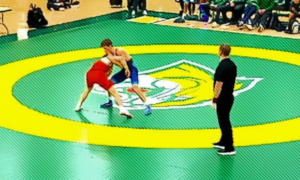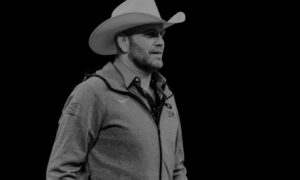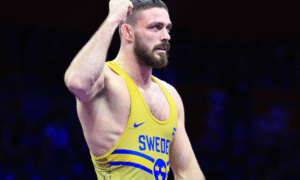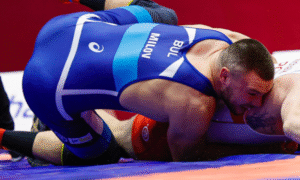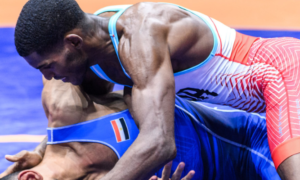Coming at you is the first in a three-part series of technique clips featuring US National Team head coach Matt Lindland and Northern Michigan University/Olympic Training Site assistant coach Andy Bisek. The objective of these videos is to introduce positions common to Greco-Roman wrestling and present a multitude of options for athletes to attack from.
Filmed at the Combat Wrestling Club in Wisconsin, this first video focuses primarily on the two-on-one. As Lindland points out in the beginning, United World Wrestling has put an emphasis on “hooking” — underhooks, overhooks, headwraps, and the like. A two-on-one qualifies as hooking because the tie-up, if used appropriately, can and should lead to a wrestler advancing to a scoring-friendly position.
Using a 2-on-1 tie-up to move opponents and create scoring positions
The format of the Lindland/Bisek technique series is free-flowing and not separated into specific drills. Both coaches demonstrate various methods using a two-on-one which emphasize movement and body position. Movement resulting from how the two-on-one is applied relates to both the offensive wrestler’s position and that of his opponent.
(Timestamps in parentheses)
Establishing position — Lindland (1:27): “I need to move him on my first contact,” Lindland says.
Elbows in at the start and immediately lower your elevation as you make contact. Lindland notes that this is what allows him to move his opponent backwards. The National Team coach then proceeds to demonstrate various entrances to the two-on-one, first by using his hands to control his partner’s wrists by gripping over the top before sliding in an underhook on the far side. When his partner (NMU’s Benji Peak) goes to counter the underhook, Lindland moves to the other side and collects the two-on-one.
When Lindland attacks Peak’s left side again, he focuses both of his hands on the left wrist and can transition straight into a two-on-one or underhook. The key point Lindland impresses upon the viewer is that along with his attacks, he is moving his feet and angling to the appropriate side of the body to gain control of the position.
To further illustrate the importance of footwork, Bisek shows how his leg movement can determine positioning based on his opponent’s reactions. Because he can pull and extend the two-on-one, or use it to push forward into his partner, his legs will decide the distance and help him stay in a position to make promising scoring attempts regardless of where on the mat he finds himself.
Examples of attacks off the 2-on-1 — Bisek (2:55-3:30)
“While moving an opponent with a two-on-one, they may pull away,” Bisek begins. “And when I feel them pull away, I push in, and once I feel them push back into me I am looking for one of these two attacks. Right before this section there is a period where I am pulling. I try not to go too much against what they are giving me. If they push into me, I pull. If they pull, I push.”
Bisek brings up another example from the video that takes place in the next clip (3:30-3:50).
“I am pulling and doing so in-sync with my legs and arms together,” he explains. “I kind of give pulses when I see them just starting to recover, as well as to keep them stretched out or to generate more of a reaction. But this section I feel talked more about using your body to stay close so that when you attack, you have the most control. Notice when Matt was attacking and his partner would square up (6:02). Matt changes his attack. That is how he never allows his opponent’s hand or arm to be free, by constantly applying pressure to direct it.”
Lindland — (5:07) “One thing I like to do is close my space before I reach.”
The attack Lindland offers here involves taking the two-on-one and extending the arm while moving forward to keep the arm pressed against the opponent’s body. “No space,” Lindland urges. “I’m putting the weight on his heel lines or his toe lines.” For the first attack, the weight is on Peak’s heels, so Lindland drives straight into a high dive. “If he wants to transfer his weight and fix his position to gain balance, when he does, I’m going to take it the other direction because most of the scores in Greco-Roman are behind us, not in front of us.” With that, Lindland takes the two-on-one the same way he did before, mashing the arm into Peak’s torso. From there he locks, loads, and launches a bodylock (5:48).
Reconfiguring the grasp — Bisek (6:31)
“While holding the two-on-one, me removing my hand is just trying to avoid both of us essentially having the same two-on-one,” says Bisek. “In doing so, I let go with my wrist hand and slide it up and out of reach. At the same time, I am turning my hips and keeping my high hand with his arm tight to the chest. Once my hips are turned and he is off balance, my hand finds his wrist, again taking him off of his base.”
As mentioned at the top, this is the first video in a multi-part series. Stay tuned for the next Lindland & Bisek Technique Series video, which will focus on underhooks!
CLICK HERE TO DONATE TO THE USA GRECO-ROMAN PROGRAM
SUBSCRIBE TO THE FIVE POINT MOVE PODCAST
iTunes | Stitcher | Spreaker | Google Play Music | RSS



